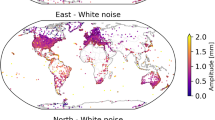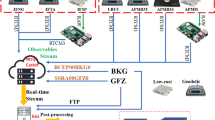Abstract
This research shows the viability of using Global Navigation Satellite System (GNSS) stations from Brazilian active networks in monitoring the ionosphere. Various indexes of ionospheric irregularities and scintillation of GNSS signals, estimated in real-time and post-processed from GNSS data, are explored for this purpose. This way, an increase in the spatial resolution of ionospheric information is provided, allowing the generation of maps of scintillation and irregularities in observing the spatial and temporal behavior of the layer’s activity cycle, since the number of ionosondes, imagers, and radars is insufficient for monitoring the irregularities in Brazil. Experiments to evaluate the estimates of the indexes are performed for periods of high and low variability of electrons. Three Brazilian networks are used: the Brazilian Network for Continuous Monitoring (RBMC), the GNSS Active Network of Sao Paulo State (GNSS-SP), and CIGALA/CALIBRA. The results are compared with data from ionosondes and PolaRxS-PRO Septentrio receivers, proving compatible with moderate to high correlations. An analysis of the seasonal variation during the peak of solar cycle 24 is carried out. The maps allow identifying the displacement of ionospheric irregularities along the magnetic equator over Brazil, from northeast to southwest, starting at 7:00 pm and ending at 2:00 am local time. Real-time monitoring is carried out for the summer solstice in the southern hemisphere, and results are consistent with those from the post-processed mode. The indexes and maps can be applied to the analysis of GNSS positioning. Real-time ionospheric information can be used in important practical applications because the displacement monitoring of irregularities allows prior knowledge of whether there will be a deterioration of positioning accuracy in a certain region.














Similar content being viewed by others
References
Blewitt G (1990) An automatic editing algorithm for GPS data. Geophys Res Lett 17(3):199–202
Bremer J, LjR C, Mielich J, Stamper R (2006) Derivation and test of ionospheric activity indices from real-time ionosonde observations in the European region. J Atmos Sol Terr Phys 68(18):2075–2090
Campbell WH (1996) Geomagnetic storms, the Dst ring-current myth and lognormal distributions. J Atmos Terr Phys 58(10):1171–1187. doi:10.1016/0021-9169(95)00103-4
Chu FD, Lee CC, Chen WS, Liu JY (2008) A study of long-term climatology of ionospheric irregularities by using GPS phase fluctuations at the Brazilian longitudes. J Adv Space Res 41(4):645–649
Conker RS, El-Arini MB, Hegarty CJ, Hsiao T (2003) Modeling the effects of ionospheric scintillation on GPS/satellite-based augmentation system availability. Radio Sci 38(1):1–23
Davies K (1990) Ionospheric radio. Peter Peregrinus Ltd, London
Forte B (2005) Optimum detrending of raw GPS data for scintillation measurements at auroral latitudes. J Atmos Sol Terr Phys 67(12):1100–1109. doi:10.1016/j.jastp.2005.01.011
Gulyaeva TL, Stanislawska I (2008) Derivation of a planetary ionospheric storm index. Ann Geophys 26(9):2645–2648 Copernicus GmbH
Gulyaeva TL, Arikan F, Hernandez-Pajares M, Stanislawska I (2013) GIM-TEC adaptive ionospheric weather assessment and forecast system. J Atmos Sol Terr Phys 102:329–340. doi:10.1016/j.jastp.2013.06.011
Hegarty C, El-Arini MB, Kim T, Ericson S (2001) Scintillation modeling for GPS-wide area augmentation system receivers. Radio Sci 36(5):1221–1231
Jakowski N, Hocke K, Schlüter S, Heise S (1999) Space weather effects detected by GPS based TEC monitoring. In: Proceedings workshop on space weather, WPP-155, ESTEC, Noordwijk, 241–244
Jakowski N, Borries C, Wilken V (2012) Introducing a new disturbance ionosphere index. Radio Sci. doi:10.1029/2011RS004939
Klobuchar J (1996) Ionospheric effects on GPS. In: Parkinson BW, Spilker JJ, Axelrad P, Enge P (eds) Global positioning system: theory and applications, I edn. Am Inst. of Aeronaut, and Astronaut., New York, pp 485–515
Matsuoka MT, Camargo PO (2004) Determination of TEC using GPS data from dual frequency receivers for the production of ionosphere maps to Brazil. Revista Brasileira de Cartografia 1(56):14–27
Mendillo M, Lin B, Aarons J (2000) The application of GPS observations to equatorial aeronomy. Radio Sci 35(3):885–904
Mielich J, Bremer J (2010) A modified index for the description of the ionospheric short and long-term activity. Ann Geophys 28(12):2227–2237. doi:10.5194/angeo-28-2227-2010 Copernicus GmbH
Mushini SC, Jayachandran PT, Langley RB, MacDougall JW, Pokhotelov D (2012) Improved amplitude-and phase-scintillation indices derived from wavelet detrended high-latitude GPS data. GPS Solut 16(3):363–373
Oladipo OA, Schüler T (2013) Equatorial ionospheric irregularities using GPS TEC derived index. J Atmos Sol Terr Phys 92:78–82
Pereira VAS, Camargo PO (2013) Estimation and analysis of the ionosphere irregularities indices using GPS data from active networks. Bol Ciênc Geod 19(3):374–390
Pereira VAS, Camargo PO (2014) Padrões para classificação dos índices de irregularidades da ionosfera: I ROT e ROTI. In: Anais do V Simpósio Brasileiro de Ciências Geodésicas e Tecnologias da Geoinformação da Universidade Federal de Pernambuco, pp 547–555
Pereira VAS, Camargo PO (2016) Scientific program for monitoring in real time or post-processed of ionospheric irregularities and scintillation of GNSS signals. Bol Ciênc Geod 22(2):282–302
Pi X, Mannucci AJ, Lindqwister UJ, Ho CM (1997) Monitoring of global ionospheric irregularities using the worldwide GPS network. Geophys Res Lett 24(18):2283–2286
Shan SJ, Liu JY, Kuo FS, Liu CC, Tsai HF (2002) GPS phase fluctuations observed along the American sector during low irregularity activity months of 1997–2000. Earth Planets Space 54(2):141–152
Van Dierendonck AJ, Klobuchar J, Hua Q (1993) Ionospheric scintillation monitoring using commercial single frequency C/A code receivers. In: Proceedings of the ION GPS 93, Institute of navigation, Salt Lake City, USA, 1333–1342
Wanninger L (1993) Ionospheric monitoring using IGS data. In: Beutler G, Brockmann E (Eds) Proceedings of the 1993 IGS workshop, Astronomical Institute, University, of Berne, 351–360
Acknowledgements
Our thanks go to the funding agencies CAPES (Coordination for the Improvement of Higher Education Personnel), FAPESP (Sao Paulo Research Foundation—process 2013/19147-1), and CNPq (National Council for Scientific and Technological Development—processes 479965/2013-7 and 309924/2013-8) for financial support, to the IBGE, the CIGALA/CALIBRA projects, the Spatial Geodesy Laboratory for the supply of GNSS data, and to INPE for the digital ionosonde data.
Author information
Authors and Affiliations
Corresponding author
Rights and permissions
About this article
Cite this article
Stuani Pereira, V.A., de Oliveira Camargo, P. Brazilian active GNSS networks as systems for monitoring the ionosphere. GPS Solut 21, 1013–1025 (2017). https://doi.org/10.1007/s10291-016-0589-y
Received:
Accepted:
Published:
Issue Date:
DOI: https://doi.org/10.1007/s10291-016-0589-y




